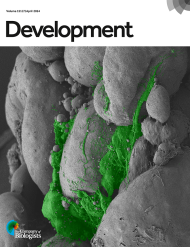Potential soil transmission of a novel Candidatus Liberibacter strain detected in citrus seedlings grown in soil from a huanglongbing infested citrus grove
Posted on: 9 November 2019
Preprint posted on 29 October 2019
da Rocha et al. report the transmission of a citrus plant pathogen in the absence of an insect vector.
Selected by Kiran GurungCategories: ecology, microbiology, plant biology
Background
The bacteria Candidatus Liberibacter spp. reportedly causes Huanglongbing (HLB) that is a disease of citrus plants. The symptoms of HLB are yellow blotches on the leaves, droopy leaves & branches and ultimately death of the whole plant.
Ca. Liberibacter is transmitted by psyllids, which are phloem feeding insects that potentially transmit the bacteria while feeding on the plant tissues. Despite the destruction of the infected plants, subsequent replanting of disease-free plants still caused HLB associated symptoms in the new plants. It is not however entirely clear whether HLB associated Ca Liberibacter is soil-borne.
Summary picture of the preprint
The data in this preprint suggest that bacteria are transmitted to the healthy plants upon replanting via the soil particles associated with previously infected plants. The researchers used soil samples from two sites which were reportedly infected with HLB back in 2009-11. The soil samples were broadly divided into 2 parts: sterile (via autoclaving) and non-sterile. Citrus seedlings were then grown and their growth monitored for 1 year in green-house in the absence of any kind of insects. After around 8.5 months, the researchers observed prominent HLB related symptoms in the plants growing on soil from one of the sites. Using the plant parts that showed HLB symptoms, the authors confirmed the presence of the Ca Liberibacter spp. using molecular methods. Moreover, according to the authors, phylogenetic analysis has revealed a novel strain of Ca Liberibacter.
Possible implication of this preprint
This article tries to ask a basic question on the transmission mode of an uncultured bacterium. It also attempts to find how a plant pathogen infects a plant in absence of its insect vector. The idea in this preprint opens up avenues for studies dealing with replant diseases.
Open questions
This article further conveys the message towards understanding the disease transmission mode.
- During collection of the soil samples from the disease infested sites, did the authors also check for the presence of HLB associated Ca Liberibacter in the original location (i.e. grove B)?
- Finally, when the HLB associated symptoms were observed on the citrus seedlings grown on the non autoclaved soil, did the authors attempt to check for the Ca Liberibacter presence (again!)?
- Would it be sufficient to conclude that the putative Ca Liberibacter is indeed a novel strain based on the amplicon size (difference), cloning, phylogenetic analysis and quantitative PCR?
Reference
- da Rocha, U. N., Shin, K., Timilsina, S., Jones, J. B., Singer, B. H., & Van Bruggen, A. H. (2019). Potential soil transmission of a novel Candidatus Liberibacter strain detected in citrus seedlings grown in soil from a huanglongbing infested citrus grove. bioRxiv, 821553.
- Picture source: Unsplash
doi: https://doi.org/10.1242/prelights.15101
Read preprintSign up to customise the site to your preferences and to receive alerts
Register hereAlso in the ecology category:
Gestational exposure to high heat-humidity conditions impairs mouse embryonic development
Girish Kale, preLights peer support
Blue appendages and temperature acclimation increase survival during acute heat stress in the upside-down jellyfish, Cassiopea xamachana
Maitri Manjunath
How the liver contributes to stomach warming in the endothermic white shark Carcharodon carcharias
Sarah Young-Veenstra
Also in the microbiology category:
Characterization of natural product inhibitors of quorum sensing in Pseudomonas aeruginosa reveals competitive inhibition of RhlR by ortho-vanillin
UofA IMB565 et al.
Feedback loop regulation between viperin and viral hemorrhagic septicemia virus through competing protein degradation pathways
UofA IMB565 et al.
Lytic bacteriophages interact with respiratory epithelial cells and induce the secretion of antiviral and proinflammatory cytokines
UofA IMB565 et al.
Also in the plant biology category:
Plasmodesmal closure elicits stress responses
Yueh Cho
Generalized Biomolecular Modeling and Design with RoseTTAFold All-Atom
Saanjbati Adhikari
Plant plasmodesmata bridges form through ER-driven incomplete cytokinesis
AND
Plasmodesmata act as unconventional membrane contact sites regulating inter-cellular molecular exchange in plants
Gwendolyn K. Kirschner
preLists in the ecology category:
preLights peer support – preprints of interest
This is a preprint repository to organise the preprints and preLights covered through the 'preLights peer support' initiative.
| List by | preLights peer support |
EMBO | EMBL Symposium: The organism and its environment
This preList contains preprints discussed during the 'EMBO | EMBL Symposium: The organism and its environment', organised at EMBL Heidelberg, Germany (May 2023).
| List by | Girish Kale |
Bats
A list of preprints dealing with the ecology, evolution and behavior of bats
| List by | Baheerathan Murugavel |
Also in the microbiology category:
BioMalPar XVI: Biology and Pathology of the Malaria Parasite
[under construction] Preprints presented at the (fully virtual) EMBL BioMalPar XVI, 17-18 May 2020 #emblmalaria
| List by | Dey Lab, Samantha Seah |
1
ECFG15 – Fungal biology
Preprints presented at 15th European Conference on Fungal Genetics 17-20 February 2020 Rome
| List by | Hiral Shah |
EMBL Seeing is Believing – Imaging the Molecular Processes of Life
Preprints discussed at the 2019 edition of Seeing is Believing, at EMBL Heidelberg from the 9th-12th October 2019
| List by | Dey Lab |
Antimicrobials: Discovery, clinical use, and development of resistance
Preprints that describe the discovery of new antimicrobials and any improvements made regarding their clinical use. Includes preprints that detail the factors affecting antimicrobial selection and the development of antimicrobial resistance.
| List by | Zhang-He Goh |
Also in the plant biology category:
‘In preprints’ from Development 2022-2023
A list of the preprints featured in Development's 'In preprints' articles between 2022-2023
| List by | Alex Eve, Katherine Brown |
The Society for Developmental Biology 82nd Annual Meeting
This preList is made up of the preprints discussed during the Society for Developmental Biology 82nd Annual Meeting that took place in Chicago in July 2023.
| List by | Joyce Yu, Katherine Brown |
CSHL 87th Symposium: Stem Cells
Preprints mentioned by speakers at the #CSHLsymp23
| List by | Alex Eve |
SDB 78th Annual Meeting 2019
A curation of the preprints presented at the SDB meeting in Boston, July 26-30 2019. The preList will be updated throughout the duration of the meeting.
| List by | Alex Eve |











 (No Ratings Yet)
(No Ratings Yet)